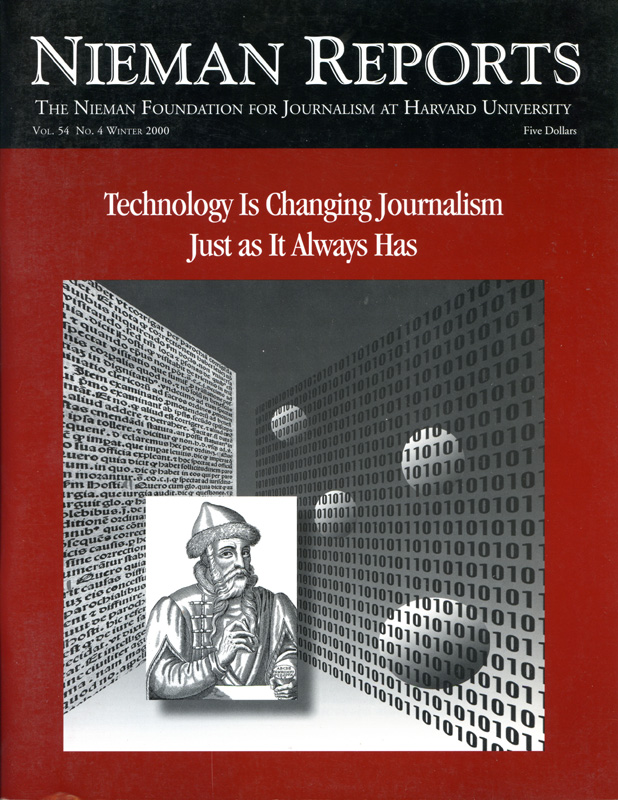Reporters can hardly cover the education beat today without computer and online technology. They must know how to use spreadsheets if they are to have any hope of making sense of the heaps of information that states and districts are amassing under the nation’s relentless push for more accountability in our schools. They need to know key Web sites on the Internet to keep up with the research reports that are pumped out nearly every day by the nation’s enormous education industry.
But no technological change has made a bigger impact on the day-to-day work of education reporters than the Education Writers Association’s listserv, an invaluable communications tool used by most of the daily education reporters in the country.
This listserv, which became active about four years ago, provides a convenient way for reporters to exchange sources, tips, opinions and insights by e-mail. Occasionally, reporters even discuss ethical concerns, such as how to handle reporting about children. When a reporter sends an e-mail to the list, everyone sees the message. Each recipient then has the option of replying personally to that reporter or to everyone on the list.
The list is particularly useful for reporters who need good sources on a tight deadline. For example, what if I had just learned the Portland School District decided to approach The Edison Project about running one of its schools, and I don’t know a thing about this organization? I can find key sources (and resources) by asking my colleagues on the listserv. Within minutes, I’ll get replies. Some will tell me how to contact the executives at Edison, a private business that operates public schools for profit. Others will put me in touch with researchers who have studied Edison schools. Information about relevant Web sites that include studies of and other stories about Edison will also be forwarded to me.
Here is an example of a recent exchange on the list:
Julie Poppen, higher education reporter for Denver Rocky Mountain News, sends an e-mail to the list to ask, “I wonder if any of you are aware of school districts that require students to attend mandatory summer school if they fail to get adequate scores on standardized tests.”
“Greenville, S.C. does it,” replies one reporter.
“Illinois does,” writes another. “Contact Lee M. at the state DOE. Also, Davenport, Iowa, schools required all second graders to go to summer school or receive special help if they didn’t make the grade.”
“Richmond Public Schools had its first mandatory summer program this year,” writes Robin Farmer, a Richmond Times-Dispatch reporter, who then provides a contact.
“Yes, Chicago does—at 3rd, 6th and 8th,” writes Linda Lenz, editor of Catalyst, a magazine on school reform. “It has for the past three summers.”
Within minutes, the reporter gets plenty of context and potential contacts for her story.
Almost any reporter on the list can give examples of how it immeasurably helped him or her on filing a deadline story. Even off deadline, the list can offer ways for every reporter to draw on the collective knowledge of the nation’s education press to pursue research and background information about an idea that hasn’t yet formed into a story. One of my favorite examples of this happened about two years ago when a reporter at the Des Moines Register was covering her local school board’s secret search for a new superintendent. The board was interviewing a job candidate, whom it wanted to keep secret. But the newspaper’s reporter and photographer staked out the board and got a photograph of the candidate going to the interview. The reporter didn’t know who the candidate was, so she put his photo on the list and asked if any of the other reporters could identify him. Another reporter identified the photo, and the reporter was then able to write her story about the “secret” candidate.
Having the ability to connect and immediately tap the expertise of the nation’s education press online would have been hard to imagine a decade ago. Technology allows us not only to move faster on stories, but also to probe deeper. Our education team at The Oregonian now almost routinely takes a new batch of test data released by the state Department of Education in the morning and, with the help of computer spreadsheets, sorts it by school on charts for each of our six zoned editions by deadline. We give readers a quick analysis that identifies weak and strong schools, compares scores to those in the previous year, and shows how each school stacks up to others with similar demographics.
Technology helps us connect and organize, but we still need to rely on good journalism to produce thoughtful stories. We still need good sources to uncover fresh information and ideas. We still need good editors to help us organize our work and tell our stories. And I know the listserv wouldn’t be so useful without so many good reporters on the other end of the line.
Bill Graves, 1999 Nieman Fellow, writes about education and other social issues for The Oregonian’s family and education team. He is immediate past president of the Education Writers Association and co-author of “Poisoned Apple,” a book about school reform.


